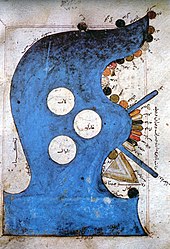This article needs additional citations for verification. (April 2011) |
Abū Ishāk al-Fārisī al-Iṣṭakhrī | |
|---|---|
| Born | |
| Died | died after 952[1] |
| Academic background | |
| Influences | Al-Balkhi |
| Academic work | |
| Era | Islamic Golden Age |
| School or tradition | Balkhi school |
| Main interests | Islamic geography |



Abu Ishaq Ibrahim ibn Muhammad al-Farisi al-Istakhri (آبو إسحاق إبراهيم بن محمد الفارسي الإصطخري) (also Estakhri, Persian: استخری, i.e. from the Iranian city of Istakhr, b. - d. 346 AH/AD 957)[2] was a 10th-century travel author and Islamic geographer who wrote valuable accounts in Arabic of the many Muslim territories he visited during the Abbasid era of the Islamic Golden Age. There is no consensus regarding his origin. Some sources describe him as Persian,[1] while others state he was Arab.[3][4] The Encyclopedia Iranica states: "Biographical data are very meager. From his nesbas (attributive names) he appears to have been a native of Eṣṭaḵr in Fārs, but it is not known whether he was Persian".[5]
Istakhri's account of windmills is the earliest known. Istakhri met the celebrated traveller-geographer Ibn Hawqal, while travelling, and Ibn Hawqal incorporated the work of Istakhri in his book Kitab al-Surat al-Ard.[4][5]
- ^ a b c d Shboul, Ahmad M. H. (1991). "Iṣṭakhrī, al-". In Kazhdan, Alexander (ed.). The Oxford Dictionary of Byzantium. Oxford and New York: Oxford University Press. ISBN 0-19-504652-8.
- ^ Mojtahed-Zadeh, Pirous. "The Persian Gulf in the Geographical Views of the Ancient World" In Cartographie Historique du Golfe Persique. Edited by M. Taleghani, D. Silva Couto, & J.-L. Bacque-Grammont. Louvain, Belgium: Diffusion, 2006. 17.
- ^ van Donzel, E.J., ed. (1994). Islamic Desk Reference (compiled from the Encyclopedia of Islam). Brill. p. 177. ISBN 978-9004097384.
- ^ a b Miquel, André (1954–2005). "Iṣṭakhrī, Abū Isḥāḳ Ibrāhīm". In Gibb, H. A. R.; Kramers, J. H.; Lévi-Provençal, E.; Schacht, J. (eds.). Encyclopaedia of Islam (2nd ed.). Leiden: Brill. IV:222b-223b.
- ^ a b Bolshakov, O. G. (1998). "Eṣṭaḵrī, Abū Esḥāq Ebrāhīm". In Yarshater, Ehsan (ed.). Encyclopædia Iranica. New York: Encyclopædia Iranica Foundation, Inc. VIII(6):646-647 (I have used the updated online version).